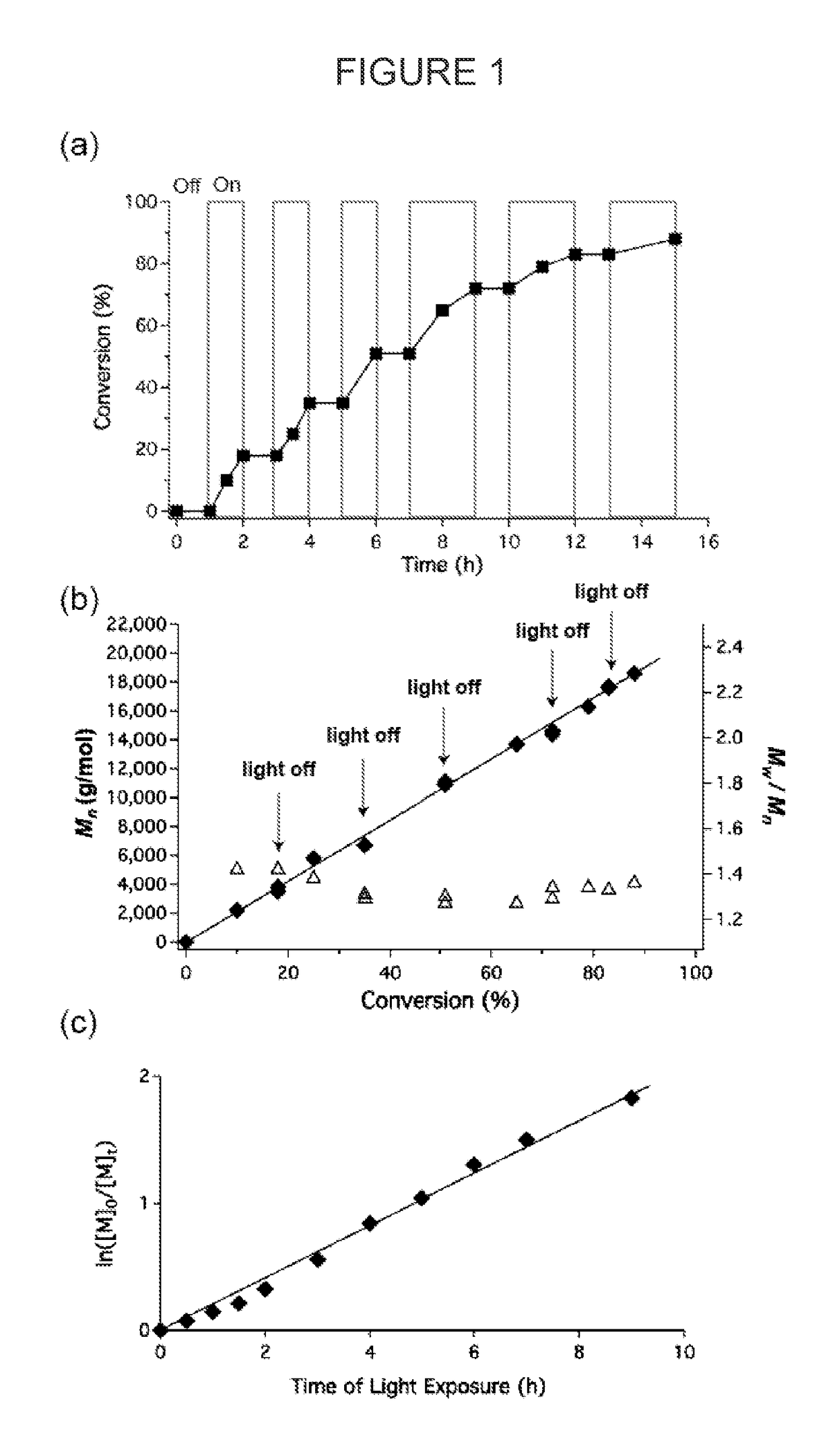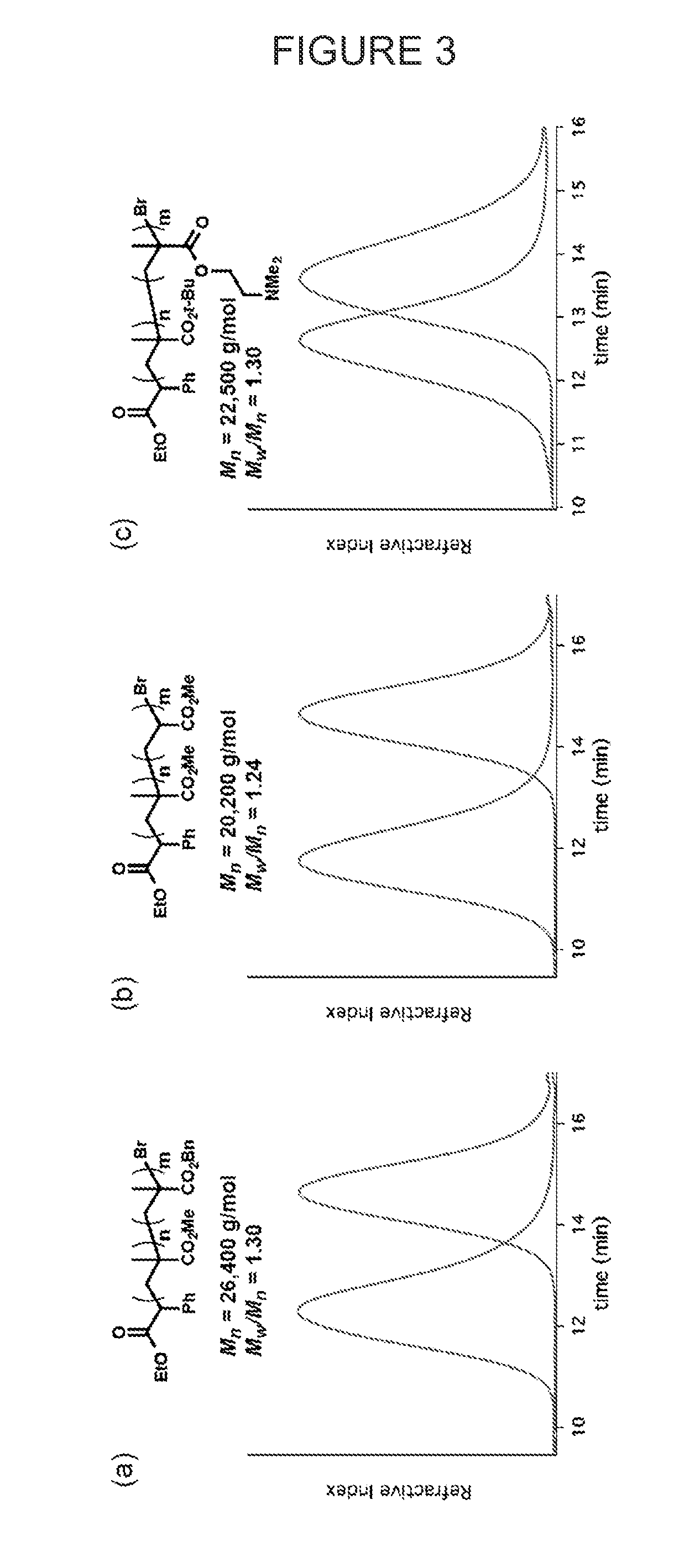Using organic photoredox catalysts to achieve metal free photoregulated controlled radical polymerization
- Summary
- Abstract
- Description
- Claims
- Application Information
AI Technical Summary
Benefits of technology
Problems solved by technology
Method used
Image
Examples
example 1
Synthesis of 10-bhenviphenothiazine (PTH):
[0104]
[0105]The following procedure was adopted from Maiti et al, (Chem. Sci. 2010, 2, 57.) To a vial armed with a magnetic stir bar was added NaOtBu (134 mg, 1.4 mmol), phenothiazine (199 mg, 1 mmol), RuPhos Precat (14 mg, 0.02 mmol, 2 mol %), and RuPhos (8 mg, 0.02 mmol, 2 mol %). The vial was evacuated and backfilled 3× with argon before adding dry Dioxane (1 mL). Lastly, anhydrous chlorobenzene (143 μL, 1.4 mmol) was added. The vial was then placed in an oil bath at 110° C. and let react for 5 h. The vial was then cooled to room temperature, diluted with OH2Cl2, washed with water, brine, dried with Mg2SO4, and run through a silica plug (5% EtOAc / Hexanes). The product was then dried under reduced pressure to yield 267 mg of a white solid (97% yield). 1H NMR (600 MHz, CDCl3) δ: 7.60 (t, J =8 Hz, 2H), 7.49 (t, J =8 Hz, 1H), 7,40 (d, J=7 Hz, 2H), 7.02 (d, J=8 Hz, 2H), 6.86-6.79 (m, 4 H), 6.20 (d, J=8 Hz, 2 H) ppm. —C NMR (151 MHz, CDCl3) δ: ...
example 2
[0107]Commercially available 10-methylphenothiazine (Me-PTH) was used for the polymerization of methyl methacrylate under similar conditions to Ir-based system disclosed in U.S. Provisional Application No. 61 / 976,178, filed April 7, 2014, and which is incorporated herein in its entirety. In short, a vial equipped with a magnetic stir bar and fitted with a teflon screw cap septum was charged with methyl methacrylate (401 μL, 3.75 mmol), photocatalyst (0.1 mol %) and dimethylacetamide (1 mL). The reaction mixture was degassed with three freeze-pump-thaw cycles. The vial was then backfilled with argon and benzyl α-bromophenylacetate (6.6 μL, 0.0375 mmol) was injected via syringe. The reaction was vigorously stirred in front of 380 nm LEDs while cooling with compressed air to maintain ambient temperature. The reaction was allowed to proceed to ca. 50% conversion of MMA as monitored by 1H NMR. An aliquot was taken and analyzed using GPC to give the molecular weight (Mn) and molecular wei...
example 3
[0108]A vial equipped with a magnetic stir bar and fitted with a rubber septum was charged with methyl methacrylate (2.4 mL, 22.5 mmol), 10-phenylphenothiazine (6.2 mg, 0.1 mol %) and dimethylacetamide (6 mL). The reaction mixture was degassed with three freeze-pump-thaw cycles. The vial was then backfilled with argon and benzyl a-bromophenylacetate (39 μL, 0.225 mmol) was injected via syringe. The reaction was stirred in front of 380 nm LEDs while cooling with compressed air to maintain ambient temperature. The reaction was stirred in front of the light for 2.5 h (14% conv.) and then put into the dark by wrapping it in aluminum foil. A syringe wrapped in aluminum foil was used to transfer the reaction mixture in the dark into a stirring solution of hexanes (50 mL, also wrapped in aluminum foil). The white precipitate was decanted, and re-dissolved in dichloromethane before precipitating again into hexanes to yield 280 mg of a white powder. Mn=2,900 g / mol, Mw / Mn=1.33.
PUM
| Property | Measurement | Unit |
|---|---|---|
| Molar density | aaaaa | aaaaa |
| Concentration | aaaaa | aaaaa |
| Polydispersity index | aaaaa | aaaaa |
Abstract
Description
Claims
Application Information
 Login to View More
Login to View More - R&D
- Intellectual Property
- Life Sciences
- Materials
- Tech Scout
- Unparalleled Data Quality
- Higher Quality Content
- 60% Fewer Hallucinations
Browse by: Latest US Patents, China's latest patents, Technical Efficacy Thesaurus, Application Domain, Technology Topic, Popular Technical Reports.
© 2025 PatSnap. All rights reserved.Legal|Privacy policy|Modern Slavery Act Transparency Statement|Sitemap|About US| Contact US: help@patsnap.com



